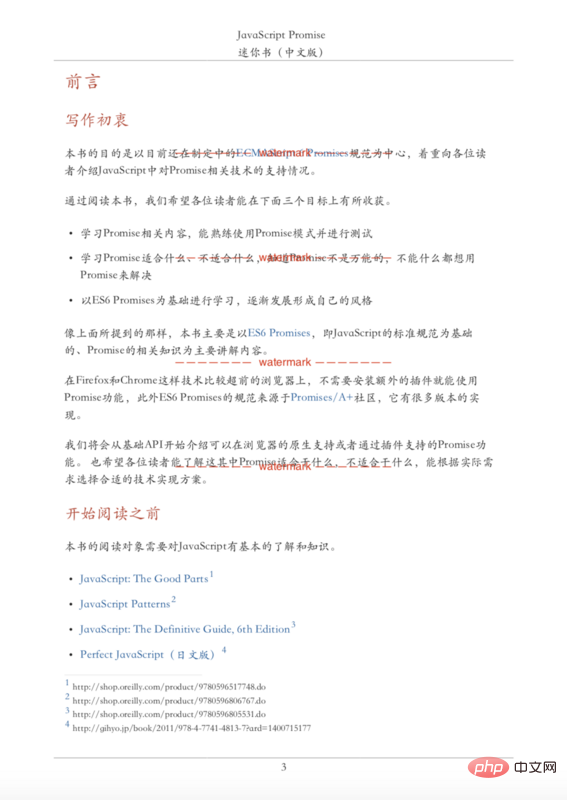How to add watermark to PDF in node.js (code example)
The content of this article is about how to add watermark to PDF with node.js (code example). It has certain reference value. Friends in need can refer to it. I hope it will be helpful to you
In the project, node is used as the middle layer. During this period, there was a need to add watermarks to PDF files. I searched many posts on the Internet and found the following problems.
1. For a single-page PDF, you can use PNG images to add to the PDF, but the actual usage is not so ideal. It must meet the effect of adding a watermark to each page of the multi-page PDF.
2. I thought about converting the PDF to pictures, adding watermarks to the pictures and then converting them back to PDF, but I felt that the intermediate steps were too cumbersome and the clarity might be reduced.
3. Python and Java have related solutions that can be implemented. I have thought about using node to execute Python scripts to add watermarks to PDFs. Considering that developers are all front-end, if maintenance is needed in the future, expansion may not be so friendly. .
Solution
I browsed Github and NPM and found that node-pdftk can meet the needs, but it has to rely on the PDFTK software. After learning more, I found that PDFTK supports linux. Good , just start using this.
Environment
If docker is used for project deployment, then use docker, which is more suitable for the situation and less troublesome; if you usually develop on your own computer, but If you need a Linux environment to practice or simulate a server environment, you can also use a Linux image to run a dokcer container, which I won’t go into details here.
Implementation
1. app.js
The API is relatively simple. In the input method, we input the source file, and in the stamp method, we input the watermark file. , specify the saved path in the out method. Here we set up a service to generate our watermarked PDF when accessing port 3100.
'use strict';
const express = require('express');
const pdftk = require('node-pdftk');
const path = require('path');
const app = express();
app.get('/', (req, res) => {
pdftk
.input(path.resolve(__dirname + '/../files/javascript.pdf'))
.stamp(path.resolve(__dirname + '/../files/watermark.pdf'))
.output(path.resolve(__dirname + '/../files/javascript_watermark.pdf'))
.then(buffer => {
return res.send('successful');
})
.catch(err => {
console.error(err);
return res.send('failed');
});
});
app.listen(3100);2, dockerfile
FROM node:7.6.0 # 创建工作目录 RUN mkdir -p /usr/src/app WORKDIR /usr/src/app COPY ./node_modules /usr/src/app/node_modules RUN npm set registry https://registry.npm.taobao.org/ # 下载安装PDFTK RUN apt-get update RUN apt-get install -y pdftk # 使用PM2启动应用 CMD ["./node_modules/pm2/bin/pm2-docker", "process.yml"]
3, effect
Source file

Watermark file

After adding watermark

The above is the detailed content of How to add watermark to PDF in node.js (code example). For more information, please follow other related articles on the PHP Chinese website!

Hot AI Tools

Undresser.AI Undress
AI-powered app for creating realistic nude photos

AI Clothes Remover
Online AI tool for removing clothes from photos.

Undress AI Tool
Undress images for free

Clothoff.io
AI clothes remover

AI Hentai Generator
Generate AI Hentai for free.

Hot Article

Hot Tools

Notepad++7.3.1
Easy-to-use and free code editor

SublimeText3 Chinese version
Chinese version, very easy to use

Zend Studio 13.0.1
Powerful PHP integrated development environment

Dreamweaver CS6
Visual web development tools

SublimeText3 Mac version
God-level code editing software (SublimeText3)

Hot Topics
 1379
1379
 52
52
 How to implement an online speech recognition system using WebSocket and JavaScript
Dec 17, 2023 pm 02:54 PM
How to implement an online speech recognition system using WebSocket and JavaScript
Dec 17, 2023 pm 02:54 PM
How to use WebSocket and JavaScript to implement an online speech recognition system Introduction: With the continuous development of technology, speech recognition technology has become an important part of the field of artificial intelligence. The online speech recognition system based on WebSocket and JavaScript has the characteristics of low latency, real-time and cross-platform, and has become a widely used solution. This article will introduce how to use WebSocket and JavaScript to implement an online speech recognition system.
 WebSocket and JavaScript: key technologies for implementing real-time monitoring systems
Dec 17, 2023 pm 05:30 PM
WebSocket and JavaScript: key technologies for implementing real-time monitoring systems
Dec 17, 2023 pm 05:30 PM
WebSocket and JavaScript: Key technologies for realizing real-time monitoring systems Introduction: With the rapid development of Internet technology, real-time monitoring systems have been widely used in various fields. One of the key technologies to achieve real-time monitoring is the combination of WebSocket and JavaScript. This article will introduce the application of WebSocket and JavaScript in real-time monitoring systems, give code examples, and explain their implementation principles in detail. 1. WebSocket technology
 How to use JavaScript and WebSocket to implement a real-time online ordering system
Dec 17, 2023 pm 12:09 PM
How to use JavaScript and WebSocket to implement a real-time online ordering system
Dec 17, 2023 pm 12:09 PM
Introduction to how to use JavaScript and WebSocket to implement a real-time online ordering system: With the popularity of the Internet and the advancement of technology, more and more restaurants have begun to provide online ordering services. In order to implement a real-time online ordering system, we can use JavaScript and WebSocket technology. WebSocket is a full-duplex communication protocol based on the TCP protocol, which can realize real-time two-way communication between the client and the server. In the real-time online ordering system, when the user selects dishes and places an order
 How to implement an online reservation system using WebSocket and JavaScript
Dec 17, 2023 am 09:39 AM
How to implement an online reservation system using WebSocket and JavaScript
Dec 17, 2023 am 09:39 AM
How to use WebSocket and JavaScript to implement an online reservation system. In today's digital era, more and more businesses and services need to provide online reservation functions. It is crucial to implement an efficient and real-time online reservation system. This article will introduce how to use WebSocket and JavaScript to implement an online reservation system, and provide specific code examples. 1. What is WebSocket? WebSocket is a full-duplex method on a single TCP connection.
 JavaScript and WebSocket: Building an efficient real-time weather forecasting system
Dec 17, 2023 pm 05:13 PM
JavaScript and WebSocket: Building an efficient real-time weather forecasting system
Dec 17, 2023 pm 05:13 PM
JavaScript and WebSocket: Building an efficient real-time weather forecast system Introduction: Today, the accuracy of weather forecasts is of great significance to daily life and decision-making. As technology develops, we can provide more accurate and reliable weather forecasts by obtaining weather data in real time. In this article, we will learn how to use JavaScript and WebSocket technology to build an efficient real-time weather forecast system. This article will demonstrate the implementation process through specific code examples. We
 How to use insertBefore in javascript
Nov 24, 2023 am 11:56 AM
How to use insertBefore in javascript
Nov 24, 2023 am 11:56 AM
Usage: In JavaScript, the insertBefore() method is used to insert a new node in the DOM tree. This method requires two parameters: the new node to be inserted and the reference node (that is, the node where the new node will be inserted).
 Simple JavaScript Tutorial: How to Get HTTP Status Code
Jan 05, 2024 pm 06:08 PM
Simple JavaScript Tutorial: How to Get HTTP Status Code
Jan 05, 2024 pm 06:08 PM
JavaScript tutorial: How to get HTTP status code, specific code examples are required. Preface: In web development, data interaction with the server is often involved. When communicating with the server, we often need to obtain the returned HTTP status code to determine whether the operation is successful, and perform corresponding processing based on different status codes. This article will teach you how to use JavaScript to obtain HTTP status codes and provide some practical code examples. Using XMLHttpRequest
 JavaScript and WebSocket: Building an efficient real-time image processing system
Dec 17, 2023 am 08:41 AM
JavaScript and WebSocket: Building an efficient real-time image processing system
Dec 17, 2023 am 08:41 AM
JavaScript is a programming language widely used in web development, while WebSocket is a network protocol used for real-time communication. Combining the powerful functions of the two, we can create an efficient real-time image processing system. This article will introduce how to implement this system using JavaScript and WebSocket, and provide specific code examples. First, we need to clarify the requirements and goals of the real-time image processing system. Suppose we have a camera device that can collect real-time image data




